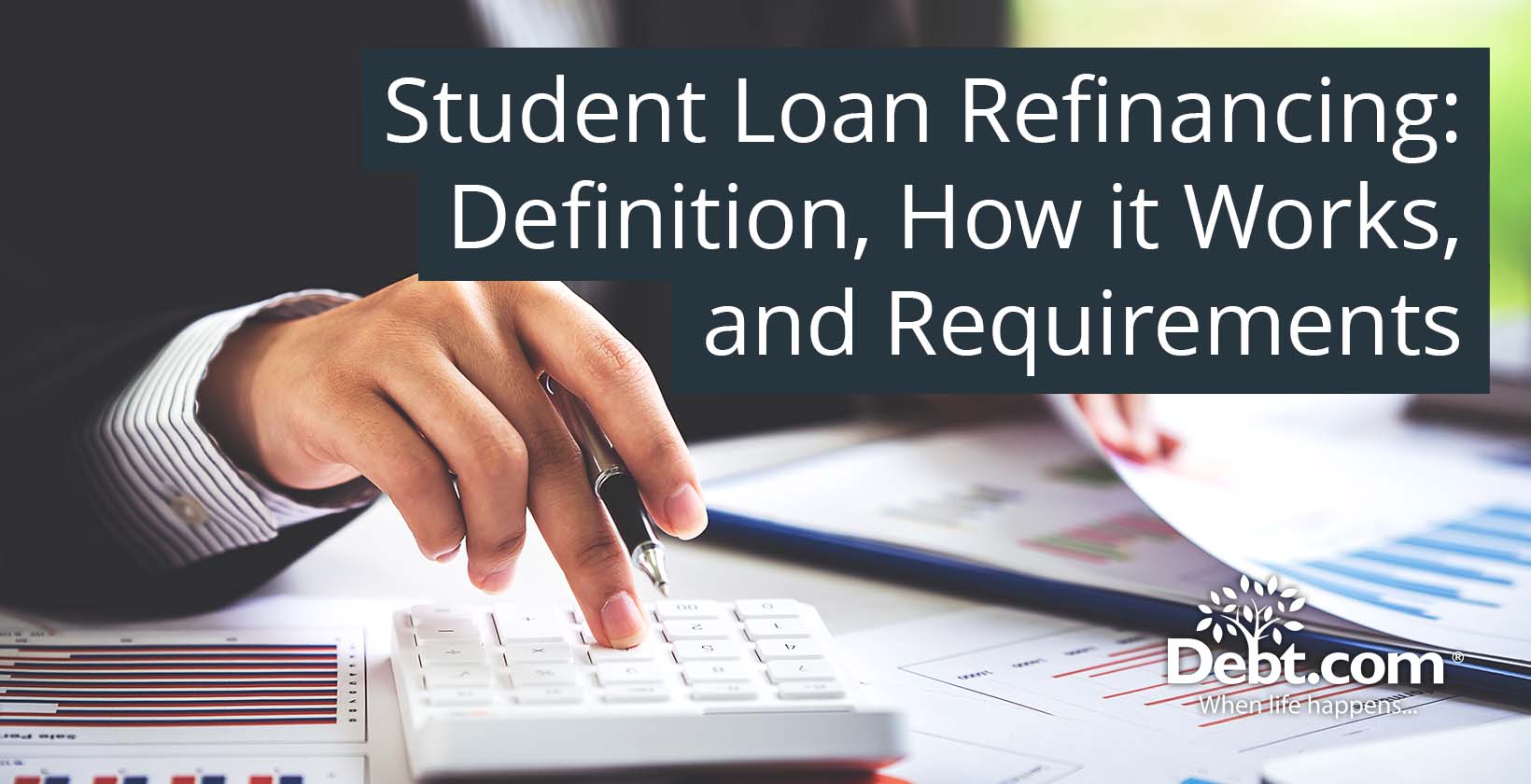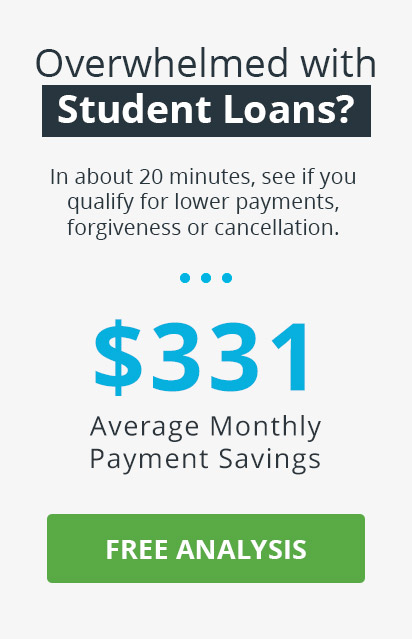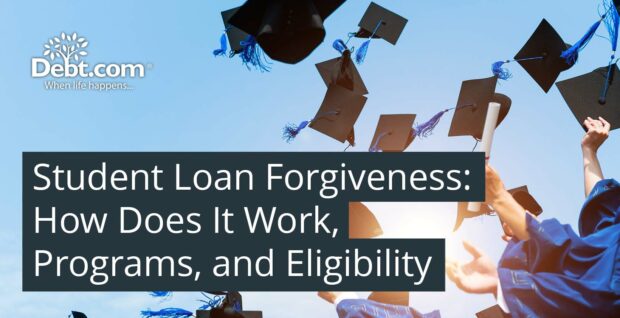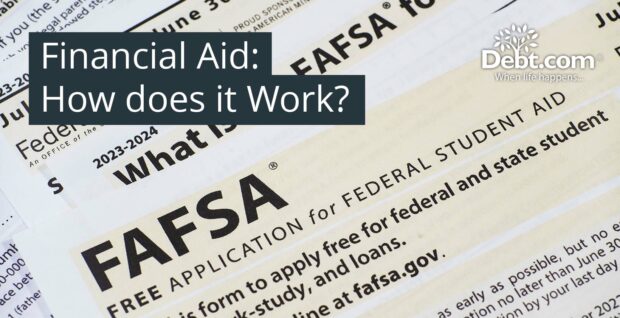
Student loan refinancing is obtaining a new loan to repay old student loans, offering updated terms like a lowered interest rate or an extended repayment period. The primary purposes of student loan refinancing are to lower monthly payments, decrease total interest costs, and consolidate multiple loans into one. Borrowers must work with private lenders, who assess their credit history and income to refinance student loans. Evaluate the financial implications, including the potential loss of federal loan benefits, and ensure the new loan terms are advantageous.
Refinancing student loans works by getting a new loan to pay off one or more existing student loans. The process allows borrowers to get a lower interest rate, a shorter repayment term, or more manageable monthly payments. It is only available through private lenders. Federal protections like income-driven repayment plans and loan forgiveness programs are forfeited when federal loans are refinanced into private loans. Student loan refinance includes researching and comparing lenders, getting prequalified, and applying formally. Borrowers must weigh the advantages and disadvantages, as extending the loan term lowers monthly payments and increases interest.
Student loan refinancing involves obtaining a new loan to repay existing student loans. The new loan offers updated terms, such as a reduced interest rate or an extended repayment period. The main goals of refinancing student loans are to lower monthly payments, decrease total interest costs, and consolidate multiple loans into one. Borrowers work with private lenders who assess their credit history and income. Evaluate the financial implications of refinancing, including the loss of federal loan benefits, and ensure the new loan terms are beneficial.
Refinancing student loans works by obtaining a new loan to pay off one or more existing student loans. The process allows borrowers to secure a lower interest rate, a shorter repayment term, or more manageable monthly payments. It is only available through private lenders, and federal protections such as income-driven repayment plans and loan forgiveness programs are forfeited when federal loans are refinanced into private loans. The process includes researching and comparing lenders, getting prequalified, and applying formally. Borrowers must weigh the benefits and drawbacks, as extending the loan term lowers monthly payments and increases interest.
The requirements for refinancing student loans include having a good credit score a FICO score of at least 650, to qualify for favorable terms. A lower debt-to-income (DTI) ratio, preferably 50% or less, is crucial as it reflects the borrower’s ability to handle additional debt. Employment status and proof of consistent income are necessary to demonstrate repayment capability. Lenders require a minimum loan balance of around $5,000 and prioritize borrowers who have finished their degree programs to ensure financial stability and reduced risk.
Table of Contents
What is Student Loan Refinancing?
Student loan refinancing is obtaining a new loan to repay existing student loans. The new loan includes updated terms, such as a reduced interest rate or a longer repayment period. Refinancing lowers monthly payments and total interest costs and allows for consolidating multiple loans into one, making repayment more manageable. A private lender assesses the borrower’s credit history and income to pay off existing debts and issue a new loan. Borrowers must review their financial status, consider the loss of federal loan benefits, and compare rates before refinancing. A good credit score is crucial for obtaining favorable student loan refinancing terms.
What is the Purpose of Student Loan Refinancing?
The purpose of student loan refinancing is to achieve financial benefits. Student loan refinancing’s primary goal is to obtain a lower interest rate and save money over the life of the loan. Refinancing reduces monthly payments, making them more manageable. It simplifies repayment by consolidating multiple loans into one new loan. Refinancing some loans allows borrowers to shorten their repayment periods at the expense of higher monthly payments. It offers more flexible repayment options, such as fixed or variable interest rates. Successful refinancing enhances the credit profile by reducing usage and demonstrating responsible debt management. Saving on interest, lowering monthly costs, simplifying repayment, and enhancing financial health are some goals, although consider possible drawbacks for borrowers with federal loans.
What is the Importance of Student Loan Refinancing?
The importance of student loan refinancing lies in its ability to provide lower interest rates, reduced monthly payments, repayment flexibility, simplification and consolidation, and improved credit profile. Refinancing helps borrowers achieve a lower interest rate on their student loans, leading to significant long-term savings by reducing the total interest paid over the loan’s lifetime. It is advantageous for borrowers with high-interest federal or private loans.
Reducing monthly payments is another crucial benefit. Borrowers struggling with large installments lower their monthly payments by securing a lower interest rate.
Repayment flexibility is a major advantage of refinancing. It allows borrowers to choose a repayment term that aligns with their financial goals, whether a shorter term for a quicker payoff or a longer term for reduced payments. Private refinance lenders offer additional flexibility, such as choosing between fixed or variable interest rates.
Simplification and consolidation are important benefits as well. Refinancing enables the consolidation of multiple student loans into a single loan, simplifying and easing the repayment process, which is useful for borrowers with several federal and private loans.
Successful refinancing leads to an improved credit profile. Refinancing enhances a borrower’s credit score and financial health by lowering the credit utilization ratio and demonstrating responsible debt management.
How does Student Loan Refinancing Work?
Student loan refinancing works by borrowing money from another source to repay one or more existing student loans. The main objectives are to obtain a lower interest rate, a shorter repayment term, or more manageable monthly payments. Refinancing is only available through private lenders, and refinancing federal loans means losing federal benefits like income-driven repayment plans and loan forgiveness programs.
The process starts with researching lenders and comparing interest rates, repayment terms, and features. Get prequalified to see potential rates without a hard credit check. Apply after choosing a lender, which involves a hard credit check. The new loan consolidates existing loans and pays them off, simplifying repayment. Start making monthly payments on the new loan, ideally with better terms.
Refinancing leads to lower interest rates if the borrower’s credit has improved. It reduces monthly payments if the term is extended, though it results in higher total interest over time. Consolidating multiple loans into one simplifies repayment.
Consider the loss of federal protections, such as income-driven repayment plans and loan forgiveness programs, when refinancing federal loans with a private lender. A hard credit check required for refinancing temporarily lowers the credit score. Ensuring the new interest rate is genuinely lower than the current rate is crucial. The pros and cons of refinancing must be carefully weighed by borrowers based on their financial situation.
Is it Worth it to Refinance Student Loans?
Yes, it is worth refinancing student loans under certain conditions. Refinancing is advantageous if the current interest rate on existing loans is high. Reduce the monthly payments and overall interest by obtaining a lower rate. Refinancing is not worth it if it doesn’t reduce interest rates or payments.
Potential savings are a crucial consideration. Calculating whether refinancing results in substantial savings over the loan’s life is essential. Credit score plays a key role in refinancing approval, with lenders requiring a score of at least 670. A higher credit score improves the chances of obtaining better rates and more options.
Lenders evaluate the debt-to-income ratio to ensure borrowers qualify for and afford the new loan. A lower debt-to-income ratio enhances approval chances. Refinancing federal loans into private loans results in losing federal protections, such as income-driven repayment plans and loan forgiveness programs. Refinancing federal loans is advisable only if these protections are deemed unnecessary.
Consider making extra payments if refinancing is not an option to reduce debt faster or applying for income-driven repayment plans on federal loans. Negotiate hardship assistance with the lender or set up an alternative payment plan.
What are the Eligibility Criteria for Student Loan Refinancing?
The eligibility criteria for Student Loan Refinancing are listed below.
- Good Credit Score: A FICO score of at least 650 is required. The score reflects a borrower’s history of responsible credit management and indicates a lower risk of loan default. Lenders use it to evaluate the risk and potential interest rates for refinancing. A high credit score increases the chances of approval and favorable loan terms.
- Debt-to-Income Ratio: Monthly debt payments to gross income must be 50% or less. The metric helps lenders assess financial health and the ability to manage additional debt. A lower DTI ratio suggests better financial management and improves the likelihood of refinancing approval.
- Job: Borrowers must be employed in the U.S. with a stable income. Proof of employment, such as pay stubs or bank statements, is required to verify income stability and repayment capability. A steady job ensures the borrower makes regular payments on the new loan.
- Loans: Lenders evaluate the types and amounts of existing loans. A minimum loan balance of $5,000 is required. Preferences or restrictions apply regarding federal versus private student loans. Loan specifics, including interest rates and repayment schedules, influence the decision to refinance.
- Graduation Status: Lenders require borrowers to have completed their degree program. Graduation indicates that the borrower is likely to have a stable income and is less risky. The status helps lenders ensure applicants have the financial maturity to handle the refinanced loan.
1. Good Credit Score
A Good Credit Score is a FICO score of at least 650, a crucial eligibility criterion for student loan refinancing. The score indicates a lower risk of loan default by reflecting a borrower’s history of responsible credit management. A high credit score demonstrates consistent on-time payments and effective debt management.
A credit score is an eligibility criterion because it helps lenders assess the risk of extending a new loan. Higher credit scores suggest lower risk, increasing the chances of approval and better interest rates. Lenders use the credit score to evaluate a borrower’s creditworthiness and likelihood of repayment.
A good credit score is necessary for refinancing to show lenders that borrowers have a history of responsible credit management. Refinancing involves getting a new private loan to replace existing loans at a lower interest rate, so lenders prefer borrowers with strong credit histories. A good credit score signals that the borrower has made timely payments on past loans and is likely to continue doing so with the new refinanced loan.
2. Debt to Income Ratio
Debt-to-Income Ratio (DTI) is the percentage of a borrower’s gross monthly income used to service debt obligations, such as student loans, credit cards, and mortgages. Lenders require a DTI ratio of 50% or less for student loan refinancing. A lower DTI ratio suggests better financial management and increases the chances of approval and favorable loan terms.
The DTI ratio is crucial in refinancing because it helps lenders assess borrowers’ financial health and ability to handle additional debt. The ratio shows how much of a borrower’s income is used for debt payments, which is essential for evaluating their capacity to manage new financial obligations. Lenders use the DTI ratio to reduce risk and make informed lending decisions as awareness of the impacts of high debt has grown.
The DTI ratio is important for refinancing because it reflects a borrower’s ability to make payments without financial strain. A lower DTI ratio indicates sufficient discretionary income, improving the chances of successful refinancing. DTI allows lenders to ensure borrowers aren’t overindebted relative to their income, enhancing their ability to manage payments and secure favorable terms. A high DTI ratio suggests potential financial distress and difficulty managing additional debt.
3. Job
Job is a crucial eligibility criterion for student loan refinancing, requiring that the borrower be employed in the U.S. and have a consistent income. A stable job demonstrates the borrower’s ability to repay the refinanced loan and meet the necessary income requirements for approval.
Proof of employment is essential as it shows the borrower’s capability to make regular payments. Lenders require documents like pay stubs and bank statements to verify a steady income. Proof of employment reduces lender risk by ensuring the borrower meets loan obligations and demonstrates financial stability.
Employment provides a reliable income source, which is vital for refinancing. A consistent paycheck assures lenders that the borrower maintains monthly payments, which is crucial for successful loan repayment. Steady income forms the foundation for assessing repayment ability and overall financial responsibility.
4. Loans
Loans are a crucial criterion for student loan refinancing, as lenders assess the types and amounts of loans a borrower holds. Lenders require a minimum overall loan balance, often $5,000, to qualify. They have preferences or restrictions regarding refinancing federal student loans, private student loans, or a combination.
The types of loans a borrower has influence the lender’s evaluation of creditworthiness and repayment ability. Lenders review loan specifics such as interest rates, repayment schedules, and total debt burden to determine whether refinancing benefits. It helps assess whether the borrower manages the new loan terms effectively.
Refinancing conditions include meeting specific loan requirements to ensure financial viability. Minimum loan balance requirements prevent lenders from accepting small amounts that do not justify the cost of underwriting and servicing. Restrictions on refinancing account for the different benefits and protections of federal versus private loans. These criteria help lenders select applicants likely to manage the refinanced loan successfully.
5. Graduation Status
Graduation status is an essential eligibility criterion for student loan refinancing because many lenders require applicants to have completed their degree program. Lenders consider refinancing for borrowers who have not yet graduated, but it is less common. Graduation status is used to assess a borrower’s creditworthiness and repayment ability.
Graduation signifies that the borrower has achieved their educational goals and is more likely to have a stable income. Borrowers who have not yet graduated are seen as riskier due to uncertain future income and employment. The criterion helps lenders focus on applicants more likely to meet the requirements for refinancing.
Requiring graduation status helps lenders minimize risk by ensuring applicants have the necessary income and financial maturity to manage the new loan. The uncertainty surrounding future income for non-graduates makes them a higher risk, so lenders prefer applicants who have completed their education and are in a stronger financial position.
What are the Rates of Student Loan Refinance?
The rates of Student Loan Refinance are listed below.
- Credible: Fixed APR rates range from 5.24% to 10.99%, and variable APR rates from 5.28% to 12.43%.
- SoFi: Offers fixed and variable APR rates from 5.24% to 9.99%.
- LendKey: Fixed APR rates are between 5.24% and 9.60%; variable APR rates are unavailable.
- Splash Financial: Provides fixed and variable APR rates from 4.99% to 9.99%.
- Laurel Road: Fixed APR rates range from 6.39% to 9.84%; variable APR rates are unavailable.
- College Ave: Fixed APR rates range from 6.99% to 13.99%; variable APR rates are unavailable.
- Rhode Island Student Loan Authority (RISLA): Fixed APR rates range from 7.30% to 8.52%; variable APR rates are unavailable.
- Earnest: Fixed Student Loan Refinance Rate ranges from 4.99% to 11.95%, and variable rates range from 5.42% to 16.20%.
How can Student Loan Refinancing help your Credit score?
Student loan refinancing can help your credit score by lowering the Debt-to-Income (DTI) Ratio. Refinancing reduces the monthly payments, thereby decreasing the DTI ratio. A lower DTI ratio signifies less financial risk to lenders, which enhances the credit score. Refinancing at a lower interest rate or extending the repayment term lowers the monthly payments, improving the financial profile.
Refinancing improves the Payment History. Consolidating multiple loans into one simplifies payment management and helps ensure timely payments. Consistently making on-time payments on the new loan builds a strong payment history, which is crucial for a good credit score.
Refinancing enhances the Credit Mix. A new refinanced loan adds diversity to the credit report, which lenders view positively as it demonstrates the ability to handle various credit types.
Refinancing impacts the Credit Utilization. The credit utilization ratio decreases if the new loan reduces the total debt. A lower credit utilization ratio generally improves the credit score, reflecting better debt management.
Does Refinancing your Student Loans Affect Your Credit Score?
Yes, refinancing your student loans affects your credit score. Applying for a new loan involves a hard credit check, temporarily lowering the score. The minor drop recovers within a few months.
The long-term impact of refinancing is improving credit scores. Combining multiple loans into one enhances credit utilization and payment history. A lower interest rate on the new loan reduces the total debt load, positively affecting the credit utilization ratio. Refinancing to a loan with a longer repayment term lowers the monthly payments and improves the debt-to-income ratio.
Use pre-qualification tools for rate estimates without a hard credit pull and compare offers from multiple lenders to minimize the impact on the credit score.
How to Refinance Private Student Loans?
To refinance private student loans, there are four steps to follow. First, compile financial data by obtaining information on income, housing expenses, total student loan debt, and predicted credit score. Lenders need the information to provide accurate rates.
Second, evaluate interest rates, costs, prepayment penalties, and options for deferment or forbearance by checking rates with several lenders. A soft credit check, which does not affect the credit score, is usually required for rate estimates.
Third, pick a lender and apply. Review the loan terms carefully, focusing on the total interest due over the loan’s term rather than just the interest rate. Submit the required paperwork to confirm financial data. Applying with a creditworthy cosigner secures a lower interest rate. Continue making payments on existing loans while waiting for the new loan approval.
Lastly, complete the refinancing process once approved. The new lender repays existing private student loans and consolidates them into a single new loan with the refinanced terms. Ensure that all previous loans are paid off to avoid late payments.
Refinancing private student loans offers reduced interest rates, improved loan conditions, and simplified payments, but federal student loan benefits are lost.
When Is the Best Time to Refinance Student Loans?
The best time to refinance student loans is as soon as possible after graduating, provided certain conditions are met. Stable income is crucial since private lenders seek borrowers who repay the new loan consistently. A low debt-to-income (DTI) ratio is ideal for demonstrating financial stability.
Good credit is necessary, with most private lenders requiring a minimum credit score of approximately 665. Higher credit scores improve the chances of securing the lowest interest rates. Refinancing is beneficial when market interest rates are low, as it allows for locking in a lower fixed rate, resulting in long-term interest savings.
Refinancing earlier leads to greater interest savings over the loan’s life. Federal student loan borrowers must wait until the current payment and interest freeze expires to retain important protections. Private student loan borrowers benefit from refinancing immediately to take advantage of low rates.
Using loan marketplaces to compare rates and terms from multiple lenders is recommended to find the best refinancing option. The ideal conditions for refinancing include a stable income, a high credit score, and the ability to secure a significantly lower interest rate. Regularly monitor interest rates and financial status to determine the best time to refinance.
How does Student Loan Consolidation Affect Interest Rates to Refinancing?
Student loan consolidation impacts refinancing interest rates by changing the calculation method and potentially impacting savings.
Direct Consolidation Loans have a weighted average interest rate based on the original loans’ rates, rounded to the nearest eighth percent when consolidated. It simplifies payments but does not lower the overall interest rate. Longer loan terms after consolidation lead to higher total interest payments.
Refinancing private student loans results in lower interest rates, notably if the borrower’s credit score has improved since the original loans. Refinancing rates are based on factors such as income and credit history, so borrowers with strong credit secure better terms.
The decision between consolidation and refinancing involves trade-offs. Consolidating federal loans offers the convenience of a single payment but does not lower rates, and if refinanced into private loans, it loses federal protections. Federal protections, like income-driven repayment plans and loan forgiveness options, are unavailable for private loans.
Borrowers must evaluate their financial situation and goals when choosing between student loan consolidation and refinancing. Federal loan consolidation provides consistency and predictability without affecting the credit score, as it does not require a credit check. Refinancing offers reduced payments and better rates but risks losing federal benefits. Understanding the long-term effects on interest rates and payment schedules is crucial for making an informed decision.
Are there any Fees Associated with Student Loan Refinancing?
Yes, there are fees associated with student loan refinancing. Lenders offer fee-free options to attract borrowers but be aware of the potential costs that arise during or after refinancing.
Refinancing student loans have no upfront fees, unlike mortgage refinancing, which involves substantial expenses. Additional costs include late payment penalties for missed payments, though many lenders provide a grace period before these fees apply. Returned payment fees are charged if a payment fails due to insufficient funds. Lenders impose an origination fee, a percentage of the loan amount, or an application fee to process the loan application, regardless of approval. Prepayment penalties apply if the loan is paid off early, as the lender misses out on future interest payments.
Borrowers must ensure they have adequate funds and make on-time payments. Setting up automatic payments helps manage responsibilities and qualify borrowers for a rate discount with some lenders. Carefully reviewing the terms and conditions of any refinancing offer is essential to avoid unexpected costs and understand the full financial impact.
Is there an Interest Rate in Refinancing Student Loans?
Yes, there is an interest rate in refinancing student loans. Private lenders set these rates and fluctuate based on market conditions and benchmarks like the Secured Overnight Financing Rate (SOFR).
Choose between fixed and variable interest rates when refinancing. Fixed rates remain constant throughout the loan term, offering predictable monthly payments. Variable rates start lower but increase based on market trends.
The average annual percentage rate (APR) for refinancing 10-year student loans is greater than 7% as of early 2024, and rates range from approximately 6% to 14%. The lowest rates are around 1.9% for variable and 3.5% for fixed, influenced by the Federal Reserve’s inflation control measures.
A borrower’s creditworthiness significantly impacts the student loan interest rate. Lenders usually require excellent credit scores, often above 780, for the best rates. Having a creditworthy cosigner helps secure a lower rate.
Assessing how interest rate changes affect repayment costs is crucial. A lower rate leads to substantial savings over the loan’s life, but extending the loan term to lower monthly payments results in higher total interest payments.
Can Refinanced Student Loans be Forgiven?
No, refinanced student loans cannot be forgiven by the federal government, regardless of the borrower’s occupation or repayment history. Federal student loan forgiveness programs, such as programs for public service employees or borrowers with long repayment histories, do not apply to loans refinanced into private loans.
Some private lenders offer forgiveness under specific circumstances, such as for disabled borrowers unable to work. Terms vary widely among lenders, so review each lender’s conditions carefully.
Refinancing federal student loans into private loans results in the loss of federal benefits, including Public Service Loan Forgiveness (PSLF) and income-driven repayment plans. These programs offer forgiveness after ten years of qualifying payments.
Biden’s student loan forgiveness plan includes provisions for some borrowers who refinanced federal loans during the pandemic. These borrowers receive a refund equivalent to their relief if they sometimes retain their federal loans.
Experts recommend caution when refinancing federal loans into private loans due to the potential loss of federal protections and forgiveness opportunities. These protections include options for deferment or forbearance during financial hardship. Borrowers must carefully consider the long-term implications of refinancing before making a decision.
What are the Best Student Loan Refinance?
The best student loan refinance options are listed below.
- Credible: Credible is recognized for its simplified refinancing process. It allows borrowers to quickly input their information and goals and provides personalized loan options from a broad network of lenders. Credible caters to diverse refinancing needs with features like filtering results by fixed or variable rates, loan terms, and monthly payments. Lenders don’t offer Parent PLUS loans, inclusive for people without degrees.
- SoFi: SoFi Student Loan Refinancing requires a minimum credit score of 650. Its fixed APR ranges from 5.24% to 9.99%, while the variable APR is between 6.24% and 9.99%. Notable features include checking rates without a hard credit inquiry and accessing a dedicated student loan debt specialist. SoFi does not offer a co-signer release option.
- LendKey: LendKey Student Loan Refinance offers fixed APRs between 5.24% and 9.60% and variable APRs from 5.53% to 8.70%. It provides a longer forbearance period of 18 months for 15- and 20-year loans and allows borrowers to check rates without a hard credit check. Availability is limited in some states, and the minimum credit score is not disclosed.
- RISLA: RISLA Student Loan Refinance has a minimum credit score requirement of 680. Fixed APRs range from 6.34% to 8.29%, and it does not offer variable rates. RISLA features an income-based repayment plan with forgiveness after 25 years and allows co-signer release after 24 months. It does not refinance Parent PLUS loans in the student’s name.
- College Ave: College Ave Student Loan Refinance requires a credit score in the mid-600s. Fixed and variable APRs are both between 6.99% and 13.99%. It offers flexible loan terms from 5 to 20 years and allows borrowers to check rates without a hard credit check. College Ave does not provide a co-signer release option.









